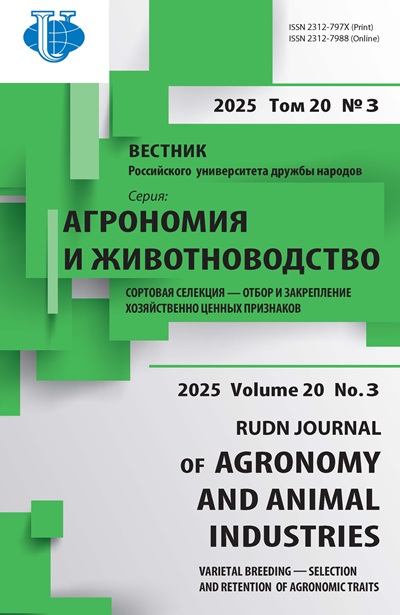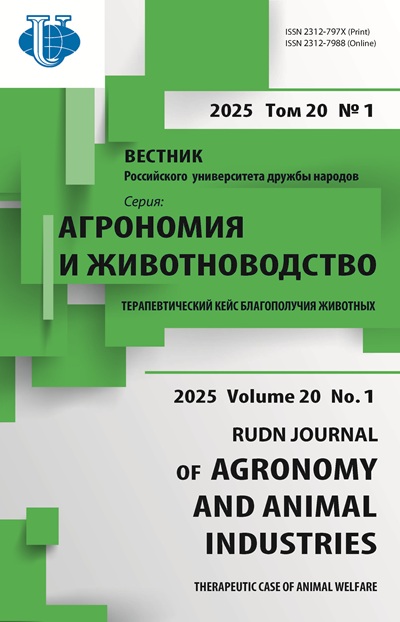Genotypic clustering of 51 soybean cultivars and wild forms using SSR-markers
- Authors: Ivaniy A.A.1, Penzin A.A.1, Bondarenko O.N.1, Blinova A.A.1, Gretchenko A.E.1, Ivachenko L.E.1, Timkin P.D.1
-
Affiliations:
- Russian Research Institute of Soybean
- Issue: Vol 20, No 1 (2025): Therapeutic case of animal welfare
- Pages: 88-101
- Section: Genetics and plant breeding
- URL: https://agrojournal.rudn.ru/agronomy/article/view/20170
- DOI: https://doi.org/10.22363/2312-797X-2025-20-1-88-101
- EDN: https://elibrary.ru/HYSNGO
- ID: 20170
Cite item
Full Text
Abstract
Soybean cultivars are characterized mainly by morphological and biochemical traits. However, researchers encounter difficulties when trying to use these parameters in cultivar identification and differentiation, making it difficult to work with closely related cultivar lines. Microsatellite markers or SSRs (simple sequence repeats) are an excellent tool for variety identification and differentiation, revealing the degree of genetic relatedness and copyright protection. The aim of the research was to obtain molecular genetic formulas for cultivated and wild soybean varieties with subsequent identification of their genetic relatedness. The object of the study was 51 samples of soybean (39 cultivars and 12 wild forms). Genomic DNA was isolated from the studied samples and then amplified. The obtained amplicons were separated in 2% agarose gel and the length of the fragments was detected in two replications. Nine microsatellite loci (Satt1, Satt2, Satt5, Satt9, Soyhsp176, Satt681, Sat_263, Satt141, Satt181) were used for molecular genetic characterization. Results demonstrating the length of each locus were analyzed by the UPGMA algorithm to record genetic relatedness or remoteness. The molecular genetic formulae of the studied samples were obtained, which can be further used to compile genetic passports. Based on the UPGMA algorithm, 51 soybean genotypes were grouped into 13 main clusters. Most of the soybean wild forms growing in the Amur Region demonstrated genetic proximity due to belonging to three closely located clusters. However, the soybean wild form from the Khabarovsk Territory (Dikaya soya 31) and one of the forms from the Amur Region (KZ-6337) were genetically distant from other groups of soybean wild forms. These results indicate the adequacy of the use of 9 SSR locuses for identification tasks, identification of relatedness and further passportization of soybeans.
Full Text
Table 1
Optimum annealing temperature
Locus | Annealing temperature, °C | |
Actual | Calculated | |
Satt1 | 60 | 60 |
Satt2 | 60 | 63 |
Satt5 | 55 | 58 |
Satt9 | 45 | 61 |
Soyhsp176 | 60 | 67 |
Satt681 | 58 | 65 |
Sat_263 | 65 | 56 |
Satt141 | 63 | 60 |
Satt181 | 63 | 50 |
Source: compiled by O.N. Bondarenko, A.A. Penzin based on experimental data.
Table 2
The molecular genetic formulas of 51 soy genotype obtained by microsatelite analysis
№ | Soy culivar / wild form | Formula* |
1 | Kruzhevnitsa | А137B154C150D206H115 J244K135L148M225 |
2 | Sentyabrinka | A145B154C136D200H115J244K135L210M208 |
3 | Vereteika | A137B154C150D212H115J244K135L187M225 |
4 | Lidiya | A137B154C150D186H115J244K135L187M208 |
5 | Umka | A137B154C136D159H115J244K135L187M225 |
6 | Dauriya | A145B154C150D168H115J244K135L187M218 |
7 | Zolushka | A154B154C160D176H115J244K135L210M208 |
8 | Lazurnaya | A145B154C150D154H115J244K135L210M185 |
9 | Topaz | A145B154C136D138H115J244K135L210M170 |
10 | Olimp | A145B154C160D186H115J244K135L210M218 |
11 | Lyana | A145B146C160D154H115J244K135L210M185 |
12 | Grei | A137B146C160D186H115J244K165L210M218 |
13 | VNIIS18 | A145B146C160D186H115J244K156L210M208 |
14 | Alpetra | A145B146C160D186H120J244K165L210M208 |
15 | Zolotnitsa | A137B154C160D212H115J244K156L210M170 |
16 | Apis | A125B154C160D212H115J244K156L210M208 |
17 | Luchistaya | A125B146C160D212H115J244K156L210M208 |
18 | Tisei | A125B146C160D206H115J244K180L210M208 |
19 | Pepelina | A137B154C160D168H115J244K156L210M208 |
20 | Charodeika | A154B163C160D186H115J200K165L210M208 |
21 | Persona | A125B146C160D212H105J220K135L187M175 |
22 | Statnaya | A125B146C165D212H105J228K135L187M170 |
23 | Evgeniya | A145B154C175D212H105J228K135L187M205 |
24 | Zhuravushka | A145B154C160D220H105J220K135L187M208 |
25 | Bonus | A137B137C175D200H105J244K156L187M195 |
26 | Lebedushka | A137B146C160D120H105J220K145L187M208 |
27 | Kukhanna | A137B146C185D120H105J244K135L187M208 |
28 | MK 100 | A137B146C185D206H115J244K135L187M208 |
29 | Nevesta | A137B146C185D186H115J244K156L187M208 |
30 | Nega 1 | A137B146C175D168H115J244K145L187M195 |
31 | Oktyabr 70 | A145B146C185D154H115J244K135L187M208 |
32 | Gratsiya | A137B146C165D148H115J244K135L187M185 |
33 | Intriga | A137B146C185D200H115J244K135L187M195 |
34 | Lastochka | A145B154C185D212H105J244K156L210M185 |
35 | Tatiana | A137B137C160D212H105J256K156L187M208 |
36 | Garmoniya | A154B146C175D212H115J244K135L187M218 |
37 | Sonata | A154B146C175D212H115J244K135L187M208 |
38 | Kitrossa | A154B146C175D176H115J244K135L187M225 |
39 | Alena | A154B137C150D168H115J200K135L187M185 |
40 | Dikaya soya 31 | A137B154C185D120H126J228K135L187M170 |
41 | KZ‑6337 | A108B146C160D186H115J200K135L148M170 |
42 | A145B176C175D120H126J244K165L210M208 | |
43 | KA‑14133 | A145B176C175D120H126J244K165L210M208 |
44 | KA‑32 | A125B176C175D120H126J244K165L210M208 |
45 | KBel‑72 | A145B176C160D120H126J244K165L210M208 |
46 | KBl‑243 | A145B176C175D120H126J244K165L210M208 |
47 | KA 3464 | A137B176C175D138H115J244K135L210M208 |
48 | A137B176C175D138H115J244K135L210M208 | |
49 | KZ‑5784 | A137B176C175D138H115J244K135L210M208 |
50 | KBl‑90 | A125B176C175D186H115J244K135L210M208 |
51 | KBl‑77 | A154B176C175D138H115J244K2135L210M208 |
Note. *Lokus code A — Satt1, B — Satt2, C — Satt5, D — Satt9, H — Soyhsp176, J — Satt681, K — Sat_263, L — Satt141, M — Satt181.
Source: compiled by A.A. Ivaniy, A.A. Penzin, O.N. Bondarenko, P.D. Timkin based on experimental data.
Fig. 1. Electrophoregram of DNA amplification products by cultivars: 2–3 — Persona; 4–5 — Statnaya; 7–8 — Evgeniya; 9–10 — Zhuravushka; 12–13 — Bonus; 14–15 — Lebedushka;
17–18 — Kukhanna using Satt181 locus
Source: compiled by A.A. Ivaniy, A.A. Blinova, A.E. Gretchenko based on experimental data.
Fig. 2. Dendrogram for 51 soybean genotype (39 cultivars and 12 wild forms)
Source: compiled by A.A. Ivaniy based on experimental data.
About the authors
Alena A. Ivaniy
Russian Research Institute of Soybean
Author for correspondence.
Email: iaa@vniisoi.ru
ORCID iD: 0009-0004-7304-7771
Junior Researcher, Laboratory of Biotechnology
19 Ignatievskoye Shosse, Blagoveshchensk, Amur region, 675027, Russian FederationAndrey A. Penzin
Russian Research Institute of Soybean
Email: paa@vniisoi.ru
ORCID iD: 0000-0002-8578-9818
SPIN-code: 1467-9500
Research Associate, Laboratory of Biotechnology
19 Ignatievskoye Shosse, Blagoveshchensk, Amur region, 675027, Russian FederationOlga N. Bondarenko
Russian Research Institute of Soybean
Email: ton@vniisoi.ru
ORCID iD: 0000-0002-5051-7695
SPIN-code: 1592-0588
Research Associate, Laboratory of Biotechnology
19 Ignatievskoye Shosse, Blagoveshchensk, Amur region, 675027, Russian FederationAnastasia A. Blinova
Russian Research Institute of Soybean
Email: baa@vniisoi.ru
ORCID iD: 0000-0002-7234-0595
SPIN-code: 8575-0595
Researcher, Head of the biotechnology laboratory
19 Ignatievskoye Shosse, Blagoveshchensk, Amur region, 675027, Russian FederationAlina E. Gretchenko
Russian Research Institute of Soybean
Email: gae@vniisoi.ru
ORCID iD: 0000-0003-3930-5672
SPIN-code: 3750-4348
Researcher, Laboratory of plant physiology and biochemistry
19 Ignatievskoye Shosse, Blagoveshchensk, Amur region, 675027, Russian FederationLyubov E. Ivachenko
Russian Research Institute of Soybean
Email: ivachenko-rog@yandex.ru
ORCID iD: 0000-0003-4870-2223
SPIN-code: 4641-4820
Doctor of Biological Sciences, Leading Researcher, Laboratory of Biotechnology
19 Ignatievskoye Shosse, Blagoveshchensk, Amur region, 675027, Russian FederationPavel D. Timkin
Russian Research Institute of Soybean
Email: tpd@vniisoi.ru
ORCID iD: 0000-0001-6655-1049
SPIN-code: 2729-2815
Junior Researcher, Laboratory of Biotechnology
19 Ignatievskoye Shosse, Blagoveshchensk, Amur region, 675027, Russian FederationReferences
- Korir NK, Han J, Shangguan L, Wang C, Kayesh E, Zhang Y, et al. Plant Variety and cultivar identification: advances and prospects. Critical Reviews in Biotechnology. 2013;33(2):111-125. doi: 10.3109/07388551.2012.675314
- Kim YH, Park HM, Hwang TY, Lee SK, Choi MS, Jho S, et al. Variation block-based genomics method for crop plants. BMC Genomics. 2014;15(1):477. doi: 10.1186/1471-2164-15-477
- Gautam AK, Verma RK, Avasthi S, Sushma, Bohra Y, Devadatha B, et al. Current insight into traditional and modern methods in fungal diversity estimates. Journal of Fungi. 2022;8(3):226. doi: 10.3390/jof8030226 EDN: SXJPCZ
- Oliveira M, Azevedo L. Molecular markers: An overview of data published for fungi over the last ten years. Journal of Fungi. 2022;8(8):803. doi: 10.3390/jof8080803 EDN: JRTUAE
- Hou X, Li L, Peng Z, Wei B, Tang S, Ding M, et al. A platform of high-density INDEL/CAPS markers for map-based cloning in Arabidopsis. The Plant Journal. 2010;63(5):880-888. doi: 10.1111/j.1365-313x.2010.04277.x
- Chaudhary R, Maurya GK. Restriction fragment length polymorphism. In: Vonk J, Shackelford TK. (eds.) Encyclopedia of Animal Cognition and Behavior. Cham, Switzerland: Springer; 2019. doi: 10.1007/978-3-319-47829-6_175-1
- Atoui A, El Khoury A. PCR-RFLP for Aspergillus species. In: Moretti A, Susca A. (eds.) Mycotoxigenic Fungi. Methods in Molecular Biology, volume 1542. New York, USA: Humana Press; 2017. p.313-320. doi: 10.1007/978-1-4939-6707-0_20
- Ibrahimi M, Brhadda N, Ziri R, Fokar M, Iraqi D, Gaboun F, et al. Analysis of genetic diversity and population structure of Moroccan date palm (Phoenix dactylifera L.) using SSR and DAMD molecular markers. Journal of Genetic Engineering and Biotechnology. 2023;21(1):66. doi: 10.1186/s43141-023-00516-7 EDN: JYOHAN
- Abugalieva SI, Zatybekov AK, Enuarbek SN, et al. Izuchenie geneticheskogo raznoobraziya i pasportizatsiya sortov soi Glycine max (L.) Merr. [Study of genetic diversity and certification of soybean varieties Glycine max (L.) Merr.]. Almaty; 2017. (In Russ.).
- Zatybekov AK, Turuspekov YT, Doszhanova BN, Abugalieva SI. A study of the genetic diversity in the world soybean collection using microsatellite markers associated with fungal disease resistance. Proceedings on applied botany, genetics and breeding. 2020;181(3):81-90. doi: 10.30901/2227-8834-2020-3-81-90 EDN: MMIRVY
- Ivaniy AA, Penzin AA. Comparative analysis of the yield of DNA released by a set of DNA-extran 3 when working with seeds and seedlings. In: Agro-industrial complex: problems and development prospects: conference proceedings. Blagoveshchensk; 2023. p.58-62. (In Russ.). doi: 10.22450/9785964205385_1_58 EDN: DPUUAN
- Ramazanova SA. Identification of soybean (Glycine max L.) cultivars using microsatellite DNA loci. Maslichnye kul’tury. Nauchno-tekhnicheskii byulleten’ Vserossiiskogo nauchno-issledovatel’skogo instituta maslichnykh kul’tur. 2016;(2):63-67. (In Russ.). EDN: WXSKMT
- Kumar SP, Susmita C, Sripathy KV, Agarwal DK, Pal G, Singh AN, et al. Molecular characterization and genetic diversity studies of Indian soybean (Glycine max (L.) Merr.) cultivars using SSR markers. Molecular Biology Reports. 2021;49(3):2129-2140. doi: 10.1007/s11033-021-07030-4
- Mukuze C, Tukamuhabwa P, Maphosa M, Dari S, Dramadri IO, Obua T, et al. Genetic diversity analysis among soybean genotypes using SSR markers in Uganda. Afr J Biotech. 2020;19(7):439-448. doi: 10.5897/ AJB2020.17152 EDN: ZRJMEW
- Bondarenko ON, Blinova AA, Ivachenko LE, Lavrentieva SI. Selection of microsatellite DNA loci for creating molecular genetic passports of wild forms and varieties of Amur soybean breeding. Vestnik of the Far East branch of the Russian Academy of Sciences. 2022;(2):37-48. (In Russ.). doi: 10.37102/08697698_2022_222_02_3 EDN: TJLSZW
Supplementary files
Source: compiled by A.A. Ivaniy, A.A. Blinova, A.E. Gretchenko based on experimental data.
Source: compiled by A.A. Ivaniy based on experimental data.

















